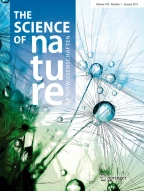1726Accesses
55Citations
41Altmetric
4Mentions
Abstract
The Cambro-Ordovician anomalocaridids are large ecdysozoans commonly regarded as ancestors of the arthropods and apex predators. Predation is indicated partly by the presence of an unusual “peytoia”-type oral cone, which is a tetraradial outer ring of 32 plates, four of which are enlarged and in perpendicular arrangement. This oral cone morphology was considered a highly consistent and defining characteristic of well-known Burgess Shale taxa. It is here shown thatAnomalocaris has a different oral cone, with only three large plates and a variable number of smaller and medium plates. Its functional morphology suggests that suction, rather than biting, was used for food ingestion, and that anomalocaridids in general employed a range of different scavenging and predatory feeding strategies. Removing anomalocaridids from the position of highly specialized trilobite predators forces a reconsideration of the ecological structure of the earliest marine animal communities in the Cambrian.
This is a preview of subscription content,log in via an institution to check access.
Access this article
Subscribe and save
- Get 10 units per month
- Download Article/Chapter or eBook
- 1 Unit = 1 Article or 1 Chapter
- Cancel anytime
Buy Now
Price includes VAT (Japan)
Instant access to the full article PDF.


References
Bergström J, Hou XG (2004) Arthropod origins. B Geosci 78:323–334
Briggs DEG, Lieberman BS, Hendricks JR, Halgedahl SL, Jarrard RD (2008) Middle Cambrian arthropods from Utah. J Paleontol 82:238–254. doi:10.1666/06-086.1
Budd GE (1996) The morphology ofOpabinia regalis and the reconstruction of the arthropod stem-group. Lethaia 29:1–14. doi:10.1111/j.1502-3931.1996.tb01831.x
Budd GE (1998) Stem group arthropods from the Lower Cambrian Sirius Passet fauna of North Greenland. In: Fortey RA, Thomas RH (eds) Arthropod relationships. Systematics Association Special Volume, London, pp 125–138
Chen JY, Ramsköld L, Zhou GQ (1994) Evidence for monophyly and arthropod affinity of Cambrian giant predators. Science 264:1304–1308. doi:10.1126/science.264.5163.1304
Collins D (1996) The “evolution” ofAnomalocaris and its classification in the arthropod class Dinocarida (Nov.) and order Radiodonta (Nov.). J Paleontol 70:280–293
Conway Morris S (1978)Laggania cambria Walcott: a composite fossil. J Paleontol 52:126–131
Daley AC, Budd GE (2010) New anomalocaridid appendages from the Burgess Shale, Canada. Palaeontology 53:721–738. doi:10.1111/j.1475-4983.2010.00955.x
Daley AC, Budd GE, Caron J-B, Edgecombe GD, Collins D (2009) The Burgess Shale anomalocarididHurdia and its significance for early Euarthropod evolution. Science 323:1597–1600. doi:10.1126/science.1169514
Edgecombe GD (2010) Arthropod phylogeny: an overview from the perspectives of morphology, molecular data and the fossil record. Arthropod Struct Dev 39:74–87. doi:10.1016/j.asd.2009.10.002
Hagadorn JW (2009) Taking a bite out ofAnomalocaris. Walcott 2009—International Conference on the Cambrian Explosion, abstract volume, 33–34.
Hagadorn JW (2010) PuttingAnomalocaris on a soft-food diet? Geol Soc Am Abstr Prog 42:320
Hou X, Bergström J, Ahlberg P (1995)Anomalocaris and other large animals in the Lower Cambrian Chengjiang fauna of southwest China. GFF 117:163–183
Hou X, Bergström J, Jie Y (2006) Distinguishing anomalocaridids from arthropods and priapulids. Geol J 41:259–269
Lieberman BS (2003) A new soft-bodied fauna: the Pioche Formation of Nevada. J Paleont 77:674–690
Ma X, Hou X, Bergström J (2009) The morphology ofLulishania longicruris (Lower Cambrian, Chengjiang Lagerstätte, SW China) and the phylogenetic relationships within lobopodians. Arthropod Struct Dev 38:271–291
Nedin C (1999)Anomalocaris predation on nonmineralized and mineralized trilobites. Geology 27:987–990
Walcott CD (1911) Middle Cambrian holothurian and medusae. Smith Misc Coll 57:41–68
Whiteaves JF (1892) Description of a new genus and species of Phyllocarid Crustacea from the Middle Cambrian of Mount Stephen. BC Can Rec Sci 5:205–208
Whittington HB, Briggs DEG (1985) The largest Cambrian animalAnomalocaris, Burgess Shale, British Columbia. Philos T Roy Soc B 390:569–609
Acknowledgments
We thank G. Budd and J-B. Caron for discussions. Comments from G. Edgecombe, J. Esteve, B. Lieberman and an anonymous reviewer improved the manuscript. J. Dougherty provided access to specimens at GSC and D. Erwin, J. Thompson and M. Florence provided access to specimens at USNM. J-B. Caron and P. Fenton provided support at the ROM. X. Ma is thanked for the photography of USNM specimens. M. Stein provided photographs that led J.B. to this discovery. Burgess Shale specimens were collected with permission from Parks Canada Research (ROM, D. Collins, 1975 to 2000). Funding from the Swedish Research Council and the Palaeontological Association to A. C. D is gratefully acknowledged. This is Royal Ontario Museum Burgess Shale Research Project 39.
Author information
Authors and Affiliations
Department of Palaeontology, Natural History Museum, Cromwell Road, London, SW7 5BD, UK
Allison C. Daley
Department of Earth Sciences, University of Bristol, Wills Memorial Building, Queen’s Road, Bristol, BS8 1RJ, UK
Allison C. Daley
Department of Palaeozoology, Swedish Museum of Natural History, P. O. Box 50007, 104 05, Stockholm, Sweden
Jan Bergström
- Allison C. Daley
You can also search for this author inPubMed Google Scholar
- Jan Bergström
You can also search for this author inPubMed Google Scholar
Corresponding author
Correspondence toAllison C. Daley.
Additional information
Communicated by: Sven Thatje
Rights and permissions
About this article
Cite this article
Daley, A.C., Bergström, J. The oral cone ofAnomalocaris is not a classic ‘‘peytoia’’.Naturwissenschaften99, 501–504 (2012). https://doi.org/10.1007/s00114-012-0910-8
Received:
Revised:
Accepted:
Published:
Issue Date:
Share this article
Anyone you share the following link with will be able to read this content:
Sorry, a shareable link is not currently available for this article.
Provided by the Springer Nature SharedIt content-sharing initiative
